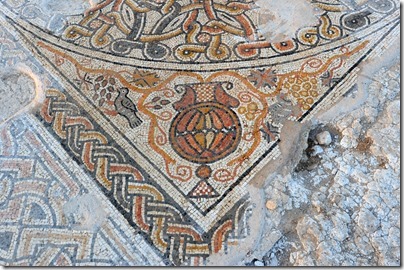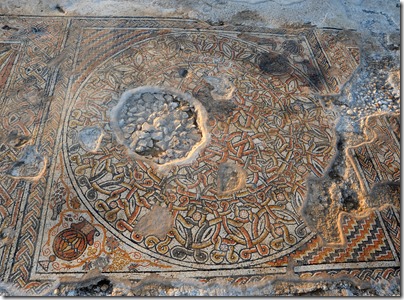A beautiful mosaic from the Byzantine period was discovered at a site north of Beersheba in a salvage excavation conducted by the Israel Antiquities Authority. From the press release:
A spectacular colorful mosaic dating to the 4th–6th centuries CE was exposed in recent weeks in the fields of Kibbutz Bet Qama, in the B’nei Shimon regional council. The mosaic was discovered within the framework of an archaeological excavation the Israel Antiquities Authority is carrying out prior to the construction of an interchange between Ma’ahaz and Devira Junction, undertaken and funded by the Cross-Israel Highway Company.
Remains of a settlement that extends across more than six dunams were uncovered in the excavation being conducted on the kibbutz’s farmland and directed by Dr. Rina Avner of the Israel Antiquities Authority.
The main building at the site was a large hall 12 meters long by 8.5 meters wide and its ceiling was apparently covered with roof tiles. The hall’s impressive opening and the breathtaking mosaic that adorns its floor suggest that the structure was a public building.
The well-preserved mosaic is decorated with geometric patterns and its corners are enhanced with amphorae (jars used to transport wine), a pair of peacocks, and a pair of doves pecking at grapes on a tendril. These are common designs that are known from this period; however, what makes this mosaic unique is the large number of motifs that were incorporated in one carpet.
Pools and a system of channels and pipes between them used to convey water were discovered in front of the building. Steps were exposed in one of the pools and its walls were treated with colored plaster (fresco).
Archaeologists in the Antiquities Authority are still trying to determine the purpose of the impressive public building and the pools whose construction required considerable economic resources.
More information, including details about tours for the public, are available on the IAA website.
High-resolution photos are available here.


